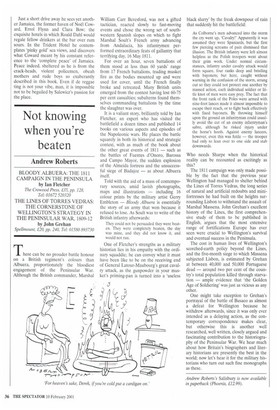Not knowing when you're beaten
Andrew Roberts
BLOODY ALBUERA: THE 1811 CAMPAIGN IN THE PENINSULA by Ian Fletcher The Crowood Press, £35, pp. 128, Tel: 01672 520320 THE LINES OF TORRES VEDRAS: THE CORNERSTONE OF WELLINGTON'S STRATEGY IN THE PENINSULAR WAR, 1809-12 by John Grehan Spellmount, £20, pp. 240, Tel: 01580 893730 There can be no prouder battle honour on a British regiment's colours than Albuera, proportionately the bloodiest engagement of the Peninsular War. Although the British commander, Marshal
William Carr Beresford, was not a gifted tactician, reacted slowly to fast-moving events and chose the wrong set of southwestern Spanish slopes on which to fight Marshal Soult's French army advancing from Andalucia, his infantrymen performed extraordinary feats of gallantry that terrifying day, 16 May 1811.
For over an hour, seven battalions of them stood at less than 60 yards' range from 17 French battalions, trading musket fire as the bodies mounted up and were used for cover, until the French finally broke and retreated. Many British units emerged from the contest having lost 60-75 per cent casualties; subalterns found themselves commanding battalions by the time the slaughter was over.
It is a valiant story, brilliantly told by Ian Fletcher, an expert who has visited the battlefield a dozen times and published 14 books on various aspects and episodes of the Napoleonic wars. He places the battle squarely in both its historical and strategic context, with as much of the book about the other great events of 1811 — such as the battles of Fuentes d'Onoro, Barossa and Campo Mayor, the sudden explosion of the Almeida fortress and the unsuccessful siege of Badajoz — as about Albuera itself.
Told with the aid of a mass of contemporary sources, amid lavish photographs, maps and illustrations — including 16 colour prints by the military artist Gerry Embleton — Bloody Albuera is essentially the story of an army that won because it refused to lose. As Soult was to write of the British infantry afterwards: They could not be persuaded they were beaten. They were completely beaten, the day was mine, and they did not know it, and would not run.
One of Fletcher's strengths as a military historian lies in his empathy with the ordinary squaddic; he can convey what it must have been like to be on the receiving end of General Latour-Maubourg's great cavalry attack, as the gunpowder in your musket's priming-pan is turned into a 'useless black slurry' by the freak downpour of rain that suddenly hit the battlefield: As Colborne's men advanced into the storm the cry went up, 'Cavalry!' Apparently it was assumed they were Spaniards, but the first few piercing screams of pain dismissed that illusion. The British infantry were left almost helpless as the Polish troopers went about their grim work. Under normal circumstances, infantry under cavalry attack would form square, four ranks deep and bristling with bayonets; but here, caught without warning in the confusion of the storm, strung out so they could not protect one another by massed action, each individual soldier or little knot of men were easy prey. The fact that the front rank of the Poles were armed with nine-foot lances made it almost impossible to escape their reach, or to fight back effectively with fixed bayonets. By throwing himself upon the ground an infantryman could usually avoid the cut of an enemy infantryman's sabre, although he risked injury under the horse's hoofs. Against enemy lancers, however, even this was futile — the trooper had only to lean over to one side and stab downwards.
Who needs Sharpe when the historical reality can be recounted as excitingly as this?
The 1811 campaign was only made possible by the fact that the previous year Wellington had managed to shelter behind the Lines of Tones Vedras, the long series of natural and artificial redoubts and minifortresses he had built on the heights surrounding Lisbon to withstand the assault of Marshal Massena. John Grehan's excellent history of the Lines, the first comprehensive study of them to be published in English, argues that the most extensive range of fortifications Europe has ever seen were crucial to Wellington's survival and eventual success in the Peninsula.
The cost in human lives of Wellington's scorched-earth policy beyond the Lines, and the five-month siege to which Massena subjected Lisbon, is estimated by Grehan at between 40,000 and 50,000 Portuguese dead — around two per cent of the country's total population killed through starvation — ample evidence that 'the Golden Age of Soldiering' was just as vicious as any other.
One might take exception to Grehan's portrayal of the battle of Busaco as almost a defeat for Wellington because he withdrew afterwards, since it was only ever intended as a delaying action, as the contemporary correspondence makes clear, but otherwise this is another well researched, well written, closely argued and fascinating contribution to the historiography of the Peninsular War. We hear much about how Britain's biographers and literary historians are presently the best in the world; now let's hear it for the military historians who turn out such fine monographs as these.
Andrew Roberts's Salisbury is now available in paperback (Phoenix, £12.99).


































































 Previous page
Previous page